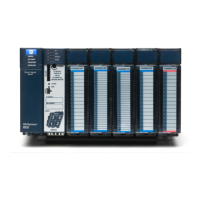Chapter 7. PID Built-In Function Block
GFK-2950C February 2018 347
7.2.2 Reference Array Parameters
Note: Machine Edition software allows you to modify the configurable parameters for a PID
instruction in real time in online programmer mode. To customize PID parameters, right click
the PID function and select Tuning.
Loop Number
Optional number of the PID block. It provides a common identification
in the CPU with the loop number defined by an operator interface
device.
0 to 255 (for
user display
only)
Algorithm
1 = ISA algorithm
2 = Independent algorithm
Sample Period
The shortest time, in 10ms. Increments, between solutions of the PID
algorithm. For example, use a 10 for a 100ms. Sample period.
Minimum time of 10ms is enforced by the block if the sweep<10ms)
0 (every
sweep) to
65535
(10.9 Min) At
least 10ms.
4,5
(Address+3,
Address+4)
Dead Band +
Dead Band –
Integral values defining the upper (+) and lower (-) Dead Band limits. If
no Dead Band is required, these values must be 0. If the PID Error (SP -
PV) or (PV - SP) is above the (-) value and below the (+) value, the PID
calculations are solved with an Error of 0. If non-zero, the (+) value
must greater than 0 and the (-) value less than 0 or the PID block will
not function.
Leave these at 0 until the PID loop gains are set up or tuned. A Dead
Band might be added to avoid small CV output changes due to
variations in error.
Dead Band +: 0
to 32767
(never
negative)
Dead Band -: -
32768 to 0
(never
positive)
PID_IND: Proportional Gain (Kp)
PID_ISA: Controller gain (Kc = Kp)
PID_IND: Change in the control variable in CV Counts for a 100 PV
Count change in the Error term. Entered as an integer representing a
fixed-point decimal ratio with two decimal places. Displayed as a ratio
of percentages with two decimal places.
For example, a Kp entered as 450 is displayed as 4.50 and results in a
Kp * Error / 100 or 450 * Error / 100 contribution to the PID Output.
PID_ISA: Same as PID_IND.
Kp is generally the first gain set when adjusting a PID loop.

